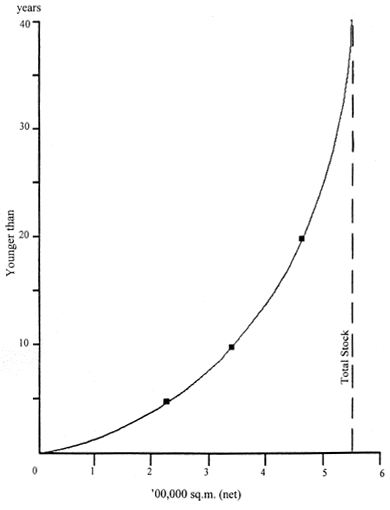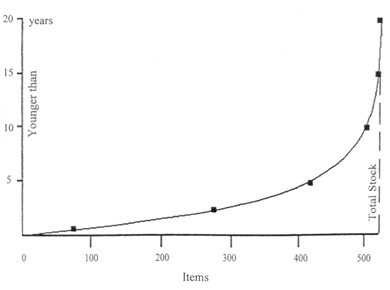UGC > About the UGC > Publications > Major reports > Higher Education in Hong Kong
- A Report by the University Grants Committee (Oct 1996) > Chapter 15: Capital Provision
Chapter 15: Capital Provision
| 15.1 | Although we do not propose, in this section of our report, to discuss recurrent funding, a review of the existing landscape would be incomplete without some reference to its most physically obvious component - the buildings and plant. Higher education in Hong Kong occupies about 120 hectares (gross) of floor space on sites which total 300 hectares. These overall figures might suggest that the institutions are well-endowed with amenity space, but in fact some individual institutions are extremely cramped. HKBU has a gross floor space to site ratio of 2.7 and PolyU one of 2.0. Even CUHK and HKUST, with gross floor space to site ratios of 0.25, have a good deal of land which, because of its steepness, is of little practical use. |
| 15.2 | The UGC judges whether an institution has sufficient space, or needs additional buildings, on the basis of a set of UK-based "norms" which relate to purpose. For example, engineering departments, assuming that they have a student/staff ratio of 9, require 9.8, 16.6 and 17.9 m2 net / fte student for undergraduates, taught postgraduates and research postgraduates respectively (net floor space is usually about two-thirds of the gross area). Libraries attract 1.46m2 net / fte student and lecture theatres 0.5m2 net / fte student. There are norms for central administration, social, sports and welfare activities. On the basis of these norms, two of the UGC institutions (CityU and PolyU) have small deficiencies of floor space and the remainder surpluses ranging from 16 to 26%. It must, however, be remembered that, particularly with the older institutions, space may not be conveniently arranged for present day teaching and research, and that some space (eg museums) serves public as well as institutional purposes. The UGC space norms are at present under review as part of the study described in paragraph 14.6, with the intention of taking more account of local factors in Hong Kong. |
| 15.3 | As well as determining total available space, the UGC is also interested in its utilisation, as is the Education Commission (see ECR 3). UGC HEIs have teaching years varying from 28 to 32 weeks. In the remainder of the time space is used for examinations, short and part-time courses, conferences and, particularly, research. Nevertheless, overall utilisation outside the teaching year is low. Within the teaching year, the UGC divides space into General Teaching Areas, where it expects 50% occupancy for 30 hours per week, and Special Teaching Areas, where it expects 50% occupancy for 22 hours per week. A recent survey by our Working Group on Space and Accommodation suggested that the institutions met, or nearly met, the standard for General Teaching Areas, but that utilisation of the Special Teaching Areas was low. A further review of utilisation will be carried out in 1996-97. |
| 15.4 | Not included so far in our discussion of capital provision is accommodation for students. The government's current limits are given in paragraph 14.5. In reality there is at present hostel accommodation available or planned for about 3,000 students at HKU and at HKUST, 5,000 at CUHK, and 1,500 at Lingnan College and at HKIEd. These 14,000 places can take about 20% of the students engaged in full-time higher education. The remaining 80% mostly live at home and may have to try to study there in noisy and congested surroundings. Additionally, students at some institutions, particularly HKU, have long journey times (see paragraph 14.6). As a result of the study carried out by our Working Group on Space and Accommodation, the UGC has recommended to government (paragraph 14.7) an increase in hostel provision of 21,200 places such as to allow every undergraduate the opportunity to spend one year on campus, every research postgraduate to have a hostel place with some additional accommodation for students who would otherwise experience very long travelling times (see Table 14.3). |
| 15.5 | The capital cost of the new hostel accommodation would be very substantial (HK$3,800m at September 1995 prices). Under existing policy, institutions would have to find 25% of this from private funds, so that the cost to the taxpayer would be HK$2,900m. There would be no implications for recurrent expenditure since hostels have to be self-financing. |
| 15.6 | The rapid expansion of the higher education system in recent years has led to the construction of many new buildings. The younger institutions (see paragraph 6.1) are all in new or substantially reconstructed accommodation and the growth of the older HEIs has required new buildings on their campuses also. The building stock is thus comparatively young. We show an age profile of the academic buildings in Figure 15.1. The same is true of equipment, particularly scientific equipment, where the UGC has made special grants for updating to the older institutions, but also of administrative equipment and plant associated with the functioning of the buildings. We show an age profile for the larger items of scientific equipment in Figure 15.2. With a small number of exceptions it can be said that the HEIs in Hong Kong currently occupy good quality buildings, many of recent date, and that they are well provided with modern equipment. Costs associated with maintenance of buildings, plant and equipment are presently low, and even in the older institutions do not exceed 11% of recurrent expenditure. |
Figure 15.1 Age Profile of Academic Buildings
in the UGC-funded Institutions (1995-96)
Source: Inter-Institutional Equipment Committee - Consolidated List of Major Equipment held by Institutions (August 1995) |

